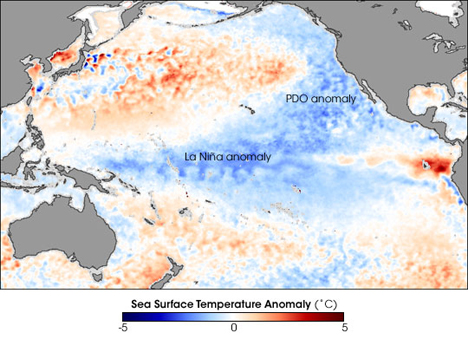La Nina and Pacific Decadal Oscillation Cool the Pacific
NASA Earth Observatory [here]
A cool-water anomaly known as La Nina occupied the tropical Pacific Ocean throughout 2007 and early 2008. In April 2008, scientists at NASA’s Jet Propulsion Laboratory announced that while the La Nina was weakening, the Pacific Decadal Oscillation-a larger-scale, slower-cycling ocean pattern-had shifted to its cool phase.

This image shows the sea surface temperature anomaly in the Pacific Ocean from April 14–21, 2008. The anomaly compares the recent temperatures measured by the Advanced Microwave Scanning Radiometer for EOS (AMSR-E) on NASA’s Aqua satellite with an average of data collected by the NOAA Pathfinder satellites from 1985–1997. Places where the Pacific was cooler than normal are blue, places where temperatures were average are white, and places where the ocean was warmer than normal are red.
The cool water anomaly in the center of the image shows the lingering effect of the year-old La Nina. However, the much broader area of cooler-than-average water off the coast of North America from Alaska (top center) to the equator is a classic feature of the cool phase of the Pacific Decadal Oscillation (PDO). The cool waters wrap in a horseshoe shape around a core of warmer-than-average water. (In the warm phase, the pattern is reversed).
Unlike El Nino and La Nina, which may occur every 3 to 7 years and last from 6 to 18 months, the PDO can remain in the same phase for 20 to 30 years. The shift in the PDO can have significant implications for global climate, affecting Pacific and Atlantic hurricane activity, droughts and flooding around the Pacific basin, the productivity of marine ecosystems, and global land temperature patterns. “This multi-year Pacific Decadal Oscillation ‘cool? trend can intensify La Nina or diminish El Nino impacts around the Pacific basin,” said Bill Patzert, an oceanographer and climatologist at NASA’s Jet Propulsion Laboratory, Pasadena, Calif. “The persistence of this large-scale pattern [in 2008] tells us there is much more than an isolated La Nina occurring in the Pacific Ocean.”
Icecap Note [here]: We have been noting this shift in the Pacific as has Bill for a while. As he says it favors more of these cool La Ninas, more tornadoes, hurricanes, winter snow, spring flooding and summer heat waves and drought - and importantly a cooling of the global temperatures, which will be augmented if cycle 24 proves to be quiet and when the AMO cycles back into its cool mode.